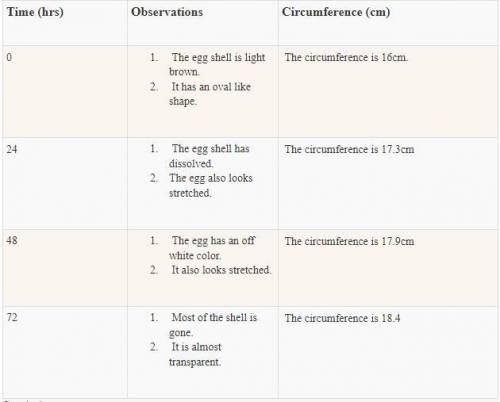Cell Transport Lab Report
Procedures:
Before beginning the experiment, record at least two ob...

Biology, 10.11.2020 20:40 2002babygurl
Cell Transport Lab Report
Procedures:
Before beginning the experiment, record at least two observations of the raw egg in your lab report.
Wrap the string around the center of the egg to determine its initial circumference. Measure the string and record the initial circumference in centimeters (cm).
Gently place the egg in the jar and completely cover the egg with vinegar. Use the lid to seal the jar, and note the time. This will be considered the “start time” of the experiment.
After approximately 24 hours from the start time, carefully remove the egg from the jar of vinegar. If the shell has completely dissolved, exposing the inner membrane, move on to the next step. If not, return the egg to the vinegar until the shell has completely dissolved.
Record at least two observations of the egg.
Measure and record the circumference of the egg, being sure to measure it in the same way every time you measure circumference.
Pour out the vinegar and rinse the jar. Then fill the jar about half full of tap water.
Gently place the egg back into the jar, making sure it is completely covered with water. Use the lid to seal the jar.
After a total of 48 hours from the start time, carefully remove the egg from the jar of water.
Make two observations of the raw egg, and measure and record the circumference.
Gently place the egg back into the jar, making sure it is completely covered with water. Use the lid to seal the jar.
After a total of 72 hours from the start time, carefully remove the egg from the jar of water.
Make two observations of the raw egg, and measure and record the circumference.
Data:
is the image.
Question:
Evaluate the lab and data collected. What type of transport occurred in this lab? Explain your answer, including evidence from your experiment to support your explanation.


Answers: 3


Another question on Biology

Biology, 21.06.2019 14:00
The image shows ekgs of a person with normal heart waves and of a person having tachycardia. based on this image, what kind of condition is tachycardia? a. the heart beats abnormally fast. b. the heart beats abnormally slow. c. the right atrium of the heart stops working. d. the left ventricle pumps less blood to the aorta.
Answers: 1

Biology, 21.06.2019 19:50
Enzymes are proteins that speed up reactions by providing an additional energy source supplying additional molecules for the reaction removing inhibitors that slow down reactions lowering the amount of energy required
Answers: 2

Biology, 22.06.2019 04:00
Indicate the coat color and the proportion of offspring with that color for each of the following crosses of rabbits. assume all are homozygous. agouti x albino a) 1/2 albino, 1/2 agouti b) all agouti c) 3/4 agouti, 1/4 albino
Answers: 2

Biology, 22.06.2019 09:40
Explain how paleontologists use trilobite fossils as index fossils for various geologic time periods.
Answers: 1
You know the right answer?
Questions



History, 22.12.2021 09:30

Mathematics, 22.12.2021 09:30

Mathematics, 22.12.2021 09:30




English, 22.12.2021 09:40













